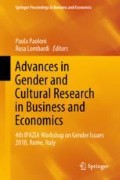Abstract
This paper aims at analysing new entrepreneurial organization models resulting from the integration of female and male elements and at finding a valid facilitator instrument for the sharing of values and objectives in the use of new technologies and communication, such as social media. On the basis of the theoretical framework of the androgynous organization, the study concentrates on the field of fashion that, in the last few years, has experimented new forms of female business connected with the creation of new markets deriving from development of the Web 2.0. The main objective of the paper is to provide greater comprehension of the role of new technologies and in particular of the social media in the development of female entrepreneurial activities, thanks to greater visibility of these new businesses, with the phenomenon of the fashion influencer at the base. The methodology of the study is based on a qualitative analysis related to the elaboration and application of the theoretical framework of the androgynous organization (Granelli and Robotti in Il valore premiante delle diversità, Harvard Business Review Italia, StrategiQs, Milano, 2016), in the case study by the fashion influencer Chiara Ferragni, at the first place in the Forbes’ Top Influencers list 2017. Through an analysis of a case study in the field of the fashion industry, an attempt has been made to illustrate the characteristics of organizations that are handling technological change in the best possible way, from the point of view of gender questions. The study carried out identifies a model that allows organisations to be much more generative and, in particular, to identify the specific characteristics of women that companies must introduce in order to become more generative. The archetypes identified are essentially hospitality, fertility and generativity, consistency, intimacy and practicality.
Access this chapter
Tax calculation will be finalised at checkout
Purchases are for personal use only
References
Ameen, N. A., & Willis, R. (2016). The use of mobile phones to support women’s entrepreneurship in the Arab countries. International Journal of Gender and Entrepreneurship, 8(4), 424–445.
Berg, B. L. (2007). Qualitative Research Methods for the Social Sciences, Pearson Eductaion, United States of America.
Cosenza, V., & Nannelli, P. (2017). Come i social media stanno trasformando il mondo del fashion (Blogmeter Report).
Cukier, W., Jackson, S., Elmi, M. A., Roach, E., & Cyr, D. (2016). Representing women? Leadership roles and women in Canadian broadcast news. Gender in Management: An International Journal, 31(5/6), 374–395.
Gackenbach, J., Yu, Y., Lee, M. N., Zhou, Z., & Yu, G. (2016). Gaming, social media, and gender in Chinese and Canadian cultures. Gender, Technology and Development, 20(3), 243–278.
Granelli, A., Robotti, O. (2016). Verso l’organizzazione “androgina”. In Il valore premiante delle diversità. La chiave per rendere la vostra azienda più forte, creativa e competitiva, Harvard Business Review Italia, StrategiQs, Milano.
Kaplan, A. M., & Haenlein, M. (2010). Users of the world, unite! The challenges and opportunities of Social Media. Business Horizons, 53(1), 59–68.
Keinan, A., Maslauskaite, K., Crener, S., & Dessain, V. (2015). The Blond Salad. Boston, MA: Harvard Business School, Harvard Business School Publishing.
Kim, W. C., & Mauborgne, R. (1999). Creating new market space. Harvard Business Review, 77(1), 83–93.
Kiron, D., Palmer, D., Phillips, A. N., & Berkman, R. (2013). Social business: Shifting out of first gear. MIT Sloan Management Review, 55(1), 1–28.
Lin, Y., Zhou, Y., & Xu, H. (2014). The hidden influence network in the fashion industry. In The 24th Annual Workshop on Information Technologies and Systems (WITS) (Vol. 1).
Mohr, I. (2013). The impact of social media on the fashion industry. The Journal of Applied Business and Economics, 15(2), 17.
Ozkazanc-Pan, B., & Clark Muntean, S. (2018). Networking towards (in) equality: Women entrepreneurs in technology. Gender, Work & Organization.
Paoloni, P. (2016). I mondi delle donne. Percorsi interdisciplinari. Edicusano, Roma.
Rashid, A. T. (2016). Digital inclusion and social inequality: Gender differences in ICT access and use in five developing countries. Gender, Technology and Development, 20(3), 306–332.
Safko, L., & Brake, D. K. (2009). The Social Media Bible: Tactics. Tools & Strategies for Business Success. Hoboken, NJ: John Wiley & Sons.
Sedeke, K., & Arora, P. (2013). Top ranking fashion blogs and their role in the current fashion industry. First Monday, 18(8).
Stake, R. (2000). Case studies. In N. K. Denzin and Y. S. Lincoln (Eds), Handbook of Qualitative Research, Thousand Oaks, Sage Publications, Inc, United States of America, pp. 435–454.
Swan, E. (2017). Postfeminist stylistics, work femininities and coaching: A multimodal study of a website. Gender, Work & Organization, 24(3), 274–296.
Thornthwaite, L., Balnave, N., & Barnes, A. (2018). Unions and social media: Prospects for gender inclusion. Gender, Work & Organization.
Van Looy, A. (2016). Social media management. Springer Texts in Business and Economics ReDIF-Book.
Yin, R. K. (2014). Case Study Research: Design and Methods. Los Angeles: SAGE.
Lithography
Author information
Authors and Affiliations
Corresponding author
Editor information
Editors and Affiliations
Rights and permissions
Copyright information
© 2019 Springer Nature Switzerland AG
About this paper
Cite this paper
Trequattrini, R., Manfredi, S., Lardo, A., Cuozzo, B. (2019). Social Media as a New Opportunity for Female Entrepreneurs: An Analysis of the Fashion Industry. In: Paoloni, P., Lombardi, R. (eds) Advances in Gender and Cultural Research in Business and Economics. IPAZIA 2018. Springer Proceedings in Business and Economics. Springer, Cham. https://doi.org/10.1007/978-3-030-00335-7_19
Download citation
DOI: https://doi.org/10.1007/978-3-030-00335-7_19
Published:
Publisher Name: Springer, Cham
Print ISBN: 978-3-030-00334-0
Online ISBN: 978-3-030-00335-7
eBook Packages: Business and ManagementBusiness and Management (R0)

